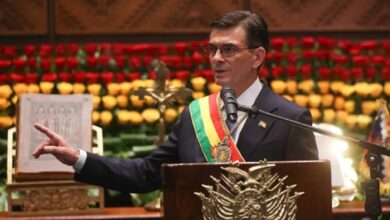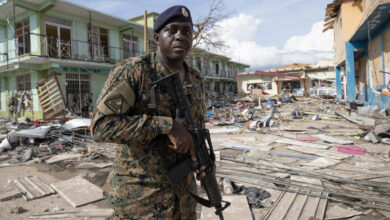Bolivia’s Last-Ditch Currency Bet: When Spare Change Becomes Crypto Lifeline

On the streets of Cochabamba, people are dropping single-boliviano coins into Bitcoin kiosks—not as speculation, but as survival. As Bolivia’s reserves vanish and its currency buckles, crypto is emerging as a lifeline in a country starved for dollars and options.
From Loose Change to Blockchain on the Sidewalk
On El Prado, Cochabamba’s bustling central boulevard, fruit carts and phone card vendors now sit alongside handwritten signs reading “Crypto Exchange.” Just steps away, a vending machine-sized Bitcoin ATM blinks to life as someone feeds in a few coins.
“I put it here because the banks don’t have dollars,” Pablo Unzueta, a restaurant owner, told Reuters. He now accepts Binance transfers for lunch plates, giving his customers a way to pay—and himself a way to avoid the costly black-market exchange for U.S. currency.
The pivot is spreading fast. One nearby beauty salon offers discounts for clients who scan a Bitcoin QR code at checkout. “It keeps my money safe,” spa owner Carla Jones told Reuters, “and maybe it even grows.”
This kind of adaptation fits a pattern first observed by sociologist Manuel Castells, who argued that crises accelerate the creation of “conversion zones”—places where economic outsiders adopt disruptive technology faster than the centers of power. In Bolivia, crypto isn’t a hedge. It’s a necessity.
Officially, the central bank reported just $24 million in digital asset trades last October. But Mauricio Torrelio, of the Bolivian Blockchain Chamber, told Reuters that volume has soared as people search for an exit from a collapsing currency. The black-market rate for the boliviano has now passed 16 to the dollar—more than double the country’s fixed official peg of 6.9.
Even though daily USDT trades average only around $600,000, former central bank president José Gabriel Espinoza told Reuters that Bolivia’s adoption speed now rivals that of Argentina and Venezuela, where inflation long ago forced people onto crypto rails.
Why a Gas-Rich Nation Is Starving for Dollars
On paper, Bolivia shouldn’t be broke. The country sits on the second-largest natural gas reserves in South America, and for years that energy wealth funded public subsidies and record growth.
But since 2014, Bolivia’s gas production has dropped nearly 40 percent, said energy economist Margarita Roca of Universidad Mayor de San Andrés in La Paz, in an interview with Reuters. Aging fields, underinvestment, and faltering exports have left the state importing expensive diesel instead of earning from exports.
That swap—fuel in, dollars out—has gutted the country’s reserves. According to data reviewed by the Inter-American Development Bank, Bolivia’s usable foreign currency reserves fell to near zero this April. Commercial banks responded by rationing dollar withdrawals. Informal exchange dealers responded by hiking rates.
That squeeze created an opening for stablecoins like USDT, whose issuers claim one-to-one parity with the U.S. dollar. In Santa Cruz, a duty-free shop now posts prices in both USDT and bolivianos. Tether CTO Paolo Ardoino tweeted the image as a symbol of “crypto adoption.”
But stablecoins come with risks. Development scholar Peter Howson of Northumbria University told Reuters that promoting crypto in crisis zones can turn into a form of “crypto-colonialism.” If a stablecoin like USDT were ever to de-peg, Bolivia’s informal dollar economy could implode overnight—with little legal recourse for ordinary users.
From Ban to Boom: Crypto’s Legal Gray Zone
Until March 2024, Bolivia had one of Latin America’s strictest bans on crypto trading, citing threats to monetary sovereignty. That changed with a quiet central bank circular that legalized “virtual asset operations” while pledging future regulation.
The move was pragmatic, said Jorge Alarcón, a financial law professor at the Catholic University of Bolivia, in an interview with Reuters. “The government had to choose: enforce a ban that people were already ignoring, or try to bring the underground economy into the daylight.”
So far, oversight is minimal. Most Bolivians use Binance, the world’s largest crypto exchange, which in 2023 admitted to anti-money laundering violations and paid a $4.3 billion fine to U.S. regulators. Yet inside Bolivia, it operates in a near-vacuum.
“This isn’t a vote of confidence in crypto,” Espinoza told Reuters. “People are going digital because the real dollars are gone.”
On paper, inflation sits around 3.5 percent. On the ground, it feels much worse. At Cochabamba’s central market, prices for cooking oil and imported goods have doubled since last year. And if the government is forced to devalue the official exchange rate, analysts like Andrés Velasco of the London School of Economics predict crypto adoption will accelerate even further.
Street-Level Innovation Meets Systemic Risk
Back on El Prado, Bitcoin advocate Andree Canelas sits under a café awning and sips maracuyá juice. He’s wired a few satoshis to pay for it—another microtransaction in a growing web of crypto survival.
Canelas told Reuters he’s installed half a dozen Bitcoin ATMs across the city. His motivation, he says, is part business, part belief. “If people hold on to bolivianos too long,” he said, “they disappear.”
Anthropologist Bill Maurer once called money a “moral technology”—a tool for expressing values as much as storing value. In Bolivia, where the state’s promise to protect savings feels increasingly hollow, crypto offers an alternate contract.
But it’s a fragile one.
A 2022 study in the Journal of Financial Stability found that in developing economies with weak banking oversight, crypto booms can magnify illegal transactions and undermine tax compliance. Howson warned that small vendors accept Bitcoin only when its price is rising. “When it drops, they stop taking it,” he said. The poor, who can’t afford to wait for rebounds, bear the brunt.
Also Read: Chile’s Queen Bees Take Flight as Global Guardians of Pollination
Still, the machines keep blinking. The queues at gas stations keep growing.
A high school student inserts a few coins into the kiosk, prints her crypto receipt, and folds it into her wallet. Across the street, the diesel line stretches for blocks.
Two currencies now battle for trust in Bolivia—one printed by a government running on fumes, the other floating in cyberspace, borderless and unbacked.
Which one wins may come down not to ideology, but to who runs out of time first.





